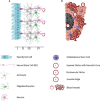The Strange Case of Jekyll and Hyde: Parallels Between Neural Stem Cells and Glioblastoma-Initiating Cells
- PMID: 33489908
- PMCID: PMC7820896
- DOI: 10.3389/fonc.2020.603738
The Strange Case of Jekyll and Hyde: Parallels Between Neural Stem Cells and Glioblastoma-Initiating Cells
Abstract
During embryonic development, radial glial precursor cells give rise to neural lineages, and a small proportion persist in the adult mammalian brain to contribute to long-term neuroplasticity. Neural stem cells (NSCs) reside in two neurogenic niches of the adult brain, the hippocampus and the subventricular zone (SVZ). NSCs in the SVZ are endowed with the defining stem cell properties of self-renewal and multipotent differentiation, which are maintained by intrinsic cellular programs, and extrinsic cellular and niche-specific interactions. In glioblastoma, the most aggressive primary malignant brain cancer, a subpopulation of cells termed glioblastoma stem cells (GSCs) exhibit similar stem-like properties. While there is an extensive overlap between NSCs and GSCs in function, distinct genetic profiles, transcriptional programs, and external environmental cues influence their divergent behavior. This review highlights the similarities and differences between GSCs and SVZ NSCs in terms of their gene expression, regulatory molecular pathways, niche organization, metabolic programs, and current therapies designed to exploit these differences.
Keywords: glioblastoma stem cells; neural stem cells; neurogenic niche; tumor metabolism; tumor microenvironment.
Copyright © 2021 Bakhshinyan, Savage, Salim, Venugopal and Singh.
Conflict of interest statement
The authors declare that the research was conducted in the absence of any commercial or financial relationships that could be construed as a potential conflict of interest.
Figures


Similar articles
-
Calcium Channels in Adult Brain Neural Stem Cells and in Glioblastoma Stem Cells.Front Cell Neurosci. 2020 Nov 13;14:600018. doi: 10.3389/fncel.2020.600018. eCollection 2020. Front Cell Neurosci. 2020. PMID: 33281564 Free PMC article. Review.
-
Immunohistochemical Detection of Neural Stem Cells and Glioblastoma Stem Cells in the Subventricular Zone of Glioblastoma Patients.J Histochem Cytochem. 2021 May;69(5):349-364. doi: 10.1369/0022155421994679. Epub 2021 Feb 17. J Histochem Cytochem. 2021. PMID: 33596115 Free PMC article.
-
Assessing the Role of Ependymal and Vascular Cells as Sources of Extracellular Cues Regulating the Mouse Ventricular-Subventricular Zone Neurogenic Niche.Front Cell Dev Biol. 2022 Apr 5;10:845567. doi: 10.3389/fcell.2022.845567. eCollection 2022. Front Cell Dev Biol. 2022. PMID: 35450289 Free PMC article. Review.
-
Grafted Subventricular Zone Neural Stem Cells Display Robust Engraftment and Similar Differentiation Properties and Form New Neurogenic Niches in the Young and Aged Hippocampus.Stem Cells Transl Med. 2016 Sep;5(9):1204-15. doi: 10.5966/sctm.2015-0270. Epub 2016 May 18. Stem Cells Transl Med. 2016. PMID: 27194744 Free PMC article.
-
The vasculature of neurogenic niches: Properties and function.Cells Dev. 2023 Jun;174:203841. doi: 10.1016/j.cdev.2023.203841. Epub 2023 Apr 14. Cells Dev. 2023. PMID: 37060947 Review.
Cited by
-
Co-Deregulated miRNA Signatures in Childhood Central Nervous System Tumors: In Search for Common Tumor miRNA-Related Mechanics.Cancers (Basel). 2021 Jun 17;13(12):3028. doi: 10.3390/cancers13123028. Cancers (Basel). 2021. PMID: 34204289 Free PMC article.
-
Deciphering the role of transcription factors in glioblastoma cancer stem cells.Acta Biochim Biophys Sin (Shanghai). 2024 May 8;56(9):1245-1255. doi: 10.3724/abbs.2024061. Acta Biochim Biophys Sin (Shanghai). 2024. PMID: 38716541 Free PMC article. Review.
-
Endothelial transdifferentiation of glioma stem cells: a literature review.Acta Neuropathol Commun. 2025 Aug 21;13(1):181. doi: 10.1186/s40478-025-02031-x. Acta Neuropathol Commun. 2025. PMID: 40841988 Free PMC article. Review.
-
Endocannabinoid signaling in glioma.Glia. 2023 Jan;71(1):127-138. doi: 10.1002/glia.24173. Epub 2022 Mar 24. Glia. 2023. PMID: 35322459 Free PMC article.
-
Targeting the neural stem cells in subventricular zone for the treatment of glioblastoma: an update from preclinical evidence to clinical interventions.Stem Cell Res Ther. 2023 May 11;14(1):125. doi: 10.1186/s13287-023-03325-4. Stem Cell Res Ther. 2023. PMID: 37170286 Free PMC article. Review.
References
Publication types
LinkOut - more resources
Full Text Sources
Other Literature Sources

